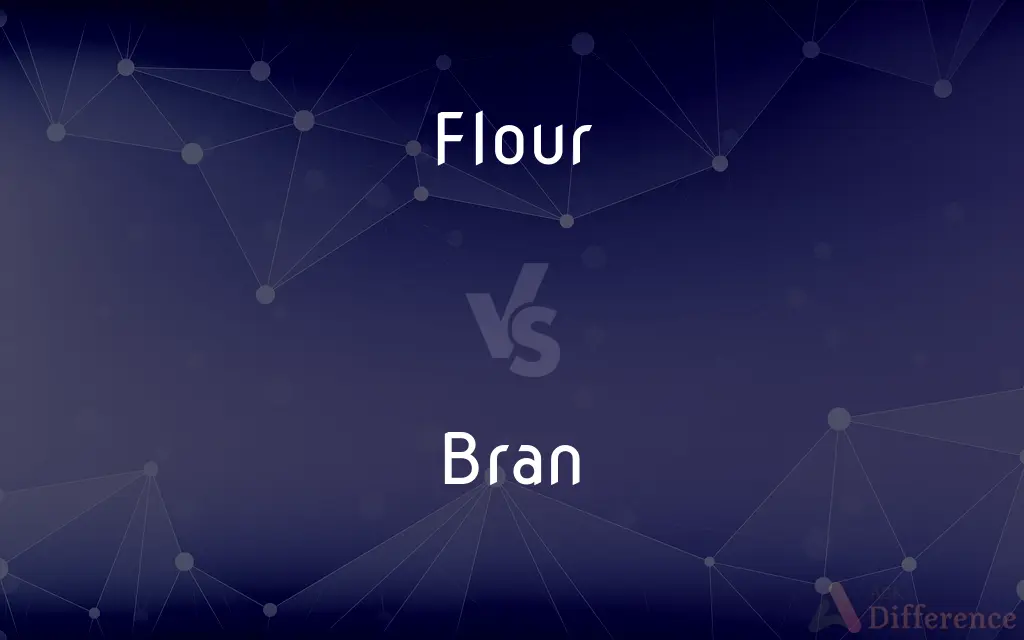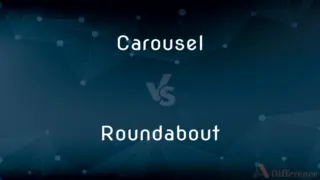Flour vs. Bran — What's the Difference?
By Maham Liaqat & Urooj Arif — Updated on April 8, 2024
Flour is a fine powder made from ground grains, used in baking and cooking, while bran is the hard outer layer of grain, rich in fiber and nutrients.

Difference Between Flour and Bran
Table of Contents
ADVERTISEMENT
Key Differences
Flour is a staple ingredient in many cuisines around the world, primarily used for making bread, pastries, and other baked goods. It is made by grinding raw grains, nuts, seeds, or roots into a fine powder. Bran, on the other hand, is the outer layer of cereal grains such as wheat, oats, and rice, removed during the milling process when making refined flour.
While flour is used as a basic component in many recipes to create structure and texture, bran is typically used as a dietary supplement or ingredient to add nutritional value and fiber to foods. The removal of bran in the production of white flour results in a finer texture and longer shelf life but also strips away significant nutritional content, which is why whole grain flours, retaining some or all of the bran, are considered healthier.
The choice between using flour and bran or a combination thereof depends on the desired nutritional content, texture, and flavor of the finished product. Whole grain flours that include bran offer a heartier texture and richer flavor, along with the health benefits of fiber and nutrients, while refined flours provide a lighter texture and neutral taste suitable for delicate baked goods.
Flour can also come from other sources like corn, rice, and oats, catering to different dietary needs and preferences. Bran is high in dietary fiber, essential fatty acids, proteins, vitamins, and minerals, making it a nutritious addition to the diet.
Comparison Chart
Source
Ground grains, nuts, seeds, or roots
Outer layer of cereal grains
ADVERTISEMENT
Use in Cooking
Basic ingredient for baking and cooking
Added for nutritional value and fiber
Nutritional Content
Varies, generally lower in fiber
High in dietary fiber, vitamins, and minerals
Texture in Food
Provides structure and texture to baked goods
Adds a hearty texture
Health Benefits
Depends on the type (whole grain vs. refined)
Aids digestion, improves heart health
Compare with Definitions
Flour
Refined flours are stripped of bran and germ, affecting nutritional value.
White flour is enriched with vitamins to compensate for lost nutrients.
Bran
Used to enrich foods with additional nutrients.
Bran muffins are a tasty way to consume more fiber.
Flour
Comes in various types like whole wheat, all-purpose, and cake flour.
She used cake flour for a lighter, fluffier sponge cake.
Bran
Whole grain flours retain bran, offering more nutrients.
Whole wheat flour includes the bran, making it healthier than refined flour.
Flour
Can be made from non-wheat sources for dietary needs.
Gluten-free recipes often use almond or rice flour.
Bran
The hard outer layers of cereal grain, removed during milling.
Wheat bran is a popular choice for boosting fiber intake.
Flour
Essential for creating the structure of baked goods.
The gluten in wheat flour helps bread rise by trapping gas bubbles.
Bran
Known for its high fiber content and health benefits.
Adding bran to your diet can help improve digestive health.
Flour
A powder obtained by grinding grains, used as a primary ingredient in bread.
The baker sifted the flour before adding it to the mixture.
Bran
Can be added to various recipes for texture and nutrition.
Oat bran is often sprinkled over yogurt or added to smoothies.
Flour
Flour is a powder made by grinding raw grains, roots, beans, nuts, or seeds. Flours are used to make many different foods.
Bran
Bran, also known as miller's bran, is the hard outer layers of cereal grain. It consists of the combined aleurone and pericarp.
Flour
A powder obtained by grinding grain, typically wheat, and used to make bread, cakes, and pastry.
Bran
A gigantic Celtic hero and ruler of Britain. After he was mortally wounded in battle, his head was buried in London, where it served as a protection against invaders.
Flour
Sprinkle (something, especially a work surface or cooking utensil) with a thin layer of flour.
Bran
The outer layers of the grain of cereals such as wheat, removed during the process of milling and used as a source of dietary fiber.
Flour
Grind (grain) into flour.
Bran
The broken coat of the seed of wheat, rye, or other cereal grain, separated from the flour or meal by sifting or bolting; the coarse, chaffy part of ground grain.
Flour
A fine, powdery foodstuff obtained by grinding and sifting the meal of a grain, especially wheat, used chiefly in baking.
Bran
(ornithology) The European carrion crow.
Flour
Any of various similar finely ground or powdered foodstuffs, as of cassava, chickpeas, or bananas.
Bran
The broken coat of the seed of wheat, rye, or other cereal grain, separated from the flour or meal by sifting or bolting; the coarse, chaffy part of ground grain.
Flour
A soft, fine powder.
Bran
The European carrion crow.
Flour
To cover or coat with flour.
Bran
Broken husks of the seeds of cereal grains that are separated from the flour by sifting
Flour
To make into flour.
Bran
Food prepared from the husks of cereal grains
Flour
Powder obtained by grinding or milling cereal grains, especially wheat, or other foodstuffs such as soybeans and potatoes, and used to bake bread, cakes, and pastry.
Flour
The food made by grinding and bolting cleaned wheat (not durum or red durum) until it meets specified levels of fineness, dryness, and freedom from bran and germ, also containing any of certain enzymes, ascorbic acid, and certain bleaching agents.
Flour
Powder of other material.
Wood flour, produced by sanding wood
Mustard flour
Flour
Obsolete form of flower
Flour
(transitive) To apply flour to something; to cover with flour.
Flour
(transitive) To reduce to flour.
Flour
(intransitive) To break up into fine globules of mercury in the amalgamation process.
Flour
The finely ground meal of wheat, or of any other grain; especially, the finer part of meal separated by bolting; hence, the fine and soft powder of any substance; as, flour of emery; flour of mustard.
Flour
To grind and bolt; to convert into flour; as, to flour wheat.
Flour
To sprinkle with flour.
Flour
Fine powdery foodstuff obtained by grinding and sifting the meal of a cereal grain
Flour
Cover with flour;
Flour fish or meat before frying it
Flour
Convert grain into flour
Common Curiosities
Why is bran removed in the production of white flour?
Bran is removed to achieve a finer texture and improve the shelf life of flour, but this also reduces the nutritional content.
Is bran gluten-free?
Bran from grains like wheat contains gluten, but rice or oat bran can be gluten-free, although cross-contamination is a concern for those with celiac disease.
What are the health benefits of consuming bran?
Bran consumption is linked to improved digestive health, lower cholesterol levels, and reduced risk of certain chronic diseases due to its high fiber and nutrient content.
How can I incorporate bran into my diet?
Bran can be added to baked goods, sprinkled over cereal or yogurt, or incorporated into smoothies for an extra fiber boost.
Can I substitute flour with bran in recipes?
Bran cannot directly replace flour due to its high fiber content and different texture. However, it can be added in small amounts to recipes for nutritional enhancement.
Do all types of flour have the same nutritional value?
No, the nutritional value of flour varies depending on the source grain and whether it's whole grain or refined. Whole grain flours retain more nutrients and fiber.
What's the difference between whole wheat flour and bran?
Whole wheat flour includes the entire grain: the bran, germ, and endosperm, offering a balance of nutrients and fiber. Bran is just the outer layer, rich in fiber but used separately.
How does the addition of bran affect baked goods?
Adding bran to baked goods increases fiber content, resulting in a denser texture and a slightly nutty flavor.
Is flour without bran unhealthy?
Flour without bran, such as white flour, lacks certain nutrients and fiber, making it less beneficial compared to whole grain options.
Can bran be used to make flour?
Bran is typically not used to make flour on its own due to its coarse texture and high fiber content, but it is included in whole grain flours.
Share Your Discovery

Previous Comparison
Carousel vs. Roundabout
Next Comparison
Biking vs. CyclingAuthor Spotlight
Written by
Maham LiaqatCo-written by
Urooj ArifUrooj is a skilled content writer at Ask Difference, known for her exceptional ability to simplify complex topics into engaging and informative content. With a passion for research and a flair for clear, concise writing, she consistently delivers articles that resonate with our diverse audience.














































